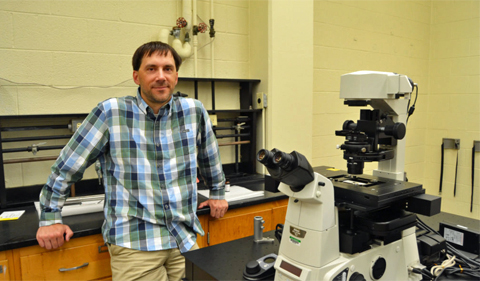In a newly published journal article, Dr. Anthony Stender and his collaborators studied the optical properties of porous silica particles that were covered with varying amounts of smaller gold nanoparticles.
Stender, Assistant Professor of Chemistry & Biochemistry at Ohio University, is a co-author on “Monitoring the Stimulated Uncapping Process of Gold-Capped Mesoporous Silica Nanoparticles” in Analytical Chemistry.
“Since Roman times, gold has frequently been used to make red stained glass. Essentially, we were studying stained glass on the nanoscale with varying ratios of silica to gold. Silica nanoparticles basically have no color in the visible range,” Stender explains. “Gold nanoparticles, however, absorb light very well between 500 and 600 nm, so the color of these systems are dependent on the amount of gold present on the silica.”
The challenging part was monitoring the color change of the silica particles as the gold was removed.
“In the key experiment, the gold nanoparticles were attached to the silica by short molecules,” Stender says. “Each silica particle had thousands of tiny gold nanoparticles present, and the gold particles were too small to be seen under the microscope, but we could see the larger silica particles. After introducing a chemical that cleaves the molecule attaching the gold to the silica, the gold floats away in solution, and the silica goes back to looking like silica.”
Stender laughed about the project got started.
“In all honesty, it was sort of an accident. My collaborators weren’t interested in the optical properties of the particles. I was doing some basic imaging for them, and the more I looked at their particles, the more confused I got. After looking at enough samples, a pattern emerged, so we kept working on the project until we had a complete story.”

















Comments